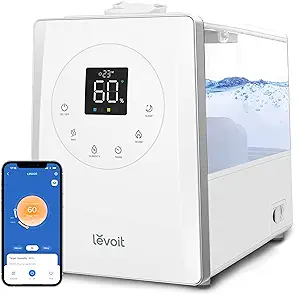Humidity levels for asthma suffers play a critical role in how well you can breathe indoors. If you’ve ever felt your chest tighten or had trouble catching your breath, the culprit might be the air’s moisture—or lack of it.
Maintaining the right indoor environment is crucial for those with asthma. While many factors contribute to the overall air quality, one of the most significant is humidity. Too much or too little moisture in the air can trigger asthma symptoms, making it essential to find the perfect balance.
In fact, according to Dr. Karen Brown, a renowned allergist and asthma specialist, “Indoor air quality is often overlooked, yet it has a profound impact on the well-being of individuals with asthma. Proper humidity levels are a key factor in reducing asthma flare-ups.”

Understanding Asthma and Indoor Air Quality
What is Asthma?
Asthma is a chronic respiratory condition characterized by inflammation and narrowing of the airways, causing difficulty in breathing, wheezing, and coughing. These symptoms can be triggered by various environmental factors, such as allergens, pollutants, and changes in temperature and humidity. Understanding these triggers and how they affect asthma is essential for effective management.
Common Symptoms of Asthma
- Shortness of breath
- Wheezing or whistling sound when exhaling
- Chest tightness or pressure
- Coughing, especially at night or early morning
- Difficulty breathing during physical activity
- Increased mucus production
- Fatigue due to breathing difficulties
Importance of Indoor Air Quality for Asthma Sufferers
Indoor air quality is a critical aspect of asthma management. Factors such as humidity, temperature, and the presence of allergens or pollutants can significantly impact asthma symptoms and overall respiratory health.
According to Dr. Michael Larson, a pulmonologist, “Poor indoor air quality can exacerbate asthma symptoms, leading to increased medication use and more frequent hospital visits. It’s essential to create a home environment that minimizes triggers.”
Role of Humidity Levels in Asthma Symptoms
Humidity levels directly influence the air quality indoors. Both high and low humidity can exacerbate asthma symptoms, making it crucial to find the right balance for a comfortable and healthy living environment. High humidity can promote the growth of mold and dust mites, both of which are common asthma triggers. Conversely, low humidity can cause the airways to become dry and irritated, leading to coughing and wheezing.

High Humidity: Why It’s Risky for Asthma Sufferers
When indoor humidity goes above 50%, things can get uncomfortable, especially if you have asthma. High humidity provides the perfect conditions for mold, mildew, and dust mites—all common asthma triggers. These allergens thrive in moist environments, and once they settle in, they’re hard to eliminate unless you control the humidity.
High humidity also makes the air feel heavy, forcing your lungs to work harder to breathe. This can lead to wheezing, shortness of breath, and even asthma attacks if left unchecked.
Low Humidity: How Dry Air Can Worsen Asthma
On the flip side, air that’s too dry can be just as harmful. Dry air can irritate your nose and throat, making the mucous membranes dry out. This can lead to more coughing, wheezing, and shortness of breath.
During colder months, when heaters are on, indoor humidity tends to drop significantly, leaving the air uncomfortably dry. It’s important to monitor your humidity levels during this time and take steps to add moisture back into the air if needed.
Best Indoor Humidity Levels for Asthma Sufferers
Ideal Humidity Levels for Asthma Relief
Maintaining an indoor humidity level between 30% and 50% is generally recommended for asthma sufferers. This range helps reduce the proliferation of dust mites, mold, and other allergens that can trigger asthma symptoms.
According to the American Lung Association, “Keeping humidity levels within the recommended range can help prevent the growth of allergens and improve overall air quality.”
Why Humidity Matters for Asthma Patients
Humidity levels that are too high or too low can lead to various respiratory issues. High humidity can promote the growth of mold and dust mites, while low humidity can cause dry airways and skin, exacerbating asthma symptoms. By maintaining the right humidity levels, you can create a comfortable and healthy living environment that supports respiratory health.
Recommended Humidity Settings for Asthma Patients at Home

For optimal asthma relief, setting your home’s humidity level between 40% and 45% can provide a comfortable and healthy environment. Using a reliable hygrometer, like the Govee WiFi Hygrometer Thermometer, helps monitor and maintain the ideal humidity levels. This device allows you to track humidity levels in real-time and adjust your settings accordingly.
How to Maintain Ideal Humidity Indoors for Asthma Relief
Using Humidifiers and Dehumidifiers
Humidifiers and dehumidifiers are essential tools for managing indoor humidity levels. A good quality humidifier, such as the LEVOIT LV600HH Hybrid Ultrasonic Humidifier, can help increase humidity levels in dry environments, while a dehumidifier can reduce excess moisture. Dr. Emily Foster, an expert in respiratory health, recommends using these devices to create an optimal indoor environment. She says, “Investing in a good humidifier or dehumidifier can make a significant difference in controlling indoor air quality and reducing asthma symptoms.”

Ventilation and Air Circulation
Proper ventilation and air circulation are crucial for maintaining optimal humidity levels. Using fans, opening windows, and ensuring good airflow can help regulate humidity and improve indoor air quality. Regularly airing out your home and using exhaust fans in bathrooms and kitchens can prevent excess moisture buildup and promote a healthier living environment.
Monitoring Humidity Levels
Regularly monitoring indoor humidity levels is essential for asthma management. Devices like the AcuRite Digital Hygrometer provide accurate readings, allowing you to adjust humidity settings as needed. This proactive approach helps you maintain the ideal environment for asthma relief.

Ideal Humidity Levels for Kids with Asthma at Home
Special Considerations for Children with Asthma
Children with asthma may have specific needs when it comes to humidity levels. Creating a safe and comfortable environment for asthmatic children involves carefully managing humidity to prevent triggers.
According to Dr. Jennifer Lee, a pediatric pulmonologist, “Children with asthma are particularly sensitive to changes in humidity. Maintaining consistent levels can help prevent asthma attacks and improve overall quality of life.”
Recommended Humidity Settings for Children’s Rooms
Maintaining a humidity level of around 40% to 45% in children’s rooms can help reduce asthma symptoms and prevent respiratory issues. Using a humidifier with a built-in hygrometer, such as the Everlasting Comfort Cool Mist Humidifiers ensures the right balance of moisture in the air. This device is designed to provide a comfortable and safe environment for children with asthma.
Tips for Managing Humidity in Kids’ Rooms
Ensuring proper ventilation, avoiding over-humidification, and using hypoallergenic bedding are some of the key tips for managing humidity in children’s rooms. These measures help create a healthy environment for asthmatic children. Additionally, using an air purifier with a HEPA filter can help remove allergens and pollutants from the air, further improving air quality.
Common Mistakes to Avoid
Over-Humidification and Its Effects
One common mistake is over-humidifying the indoor environment, which can lead to mold growth and increased allergen levels. It’s important to maintain the right balance to avoid exacerbating asthma symptoms. To prevent over-humidification, use a humidifier with an automatic shut-off feature or a built-in hygrometer to monitor moisture levels.
Neglecting Regular Maintenance of Humidifiers and Dehumidifiers
Regular cleaning and maintenance of humidifiers and dehumidifiers are crucial for their effectiveness. Neglecting maintenance can lead to the growth of bacteria and mold inside the devices, which can worsen asthma symptoms. Follow the manufacturer’s instructions for cleaning and replacing filters to ensure your devices are working properly.
Ignoring Humidity Fluctuations Throughout the Year
Humidity levels can fluctuate significantly throughout the year, especially during seasonal changes. Ignoring these fluctuations can result in improper humidity levels and increased asthma symptoms. By regularly monitoring humidity levels and making adjustments as needed, you can create a comfortable and healthy living environment year-round.
Find the Balance for Easier Breathing
Managing humidity levels for asthma is all about finding the right balance. Whether you’re dealing with too much moisture or not enough, keeping your indoor environment in the ideal range of 30% to 50% will help minimize asthma triggers and improve your quality of life. By using a humidifier, dehumidifier, and proper ventilation, you can control your home’s humidity and create a safer, more comfortable space for everyone — especially those with asthma.
Breathing easy starts with knowing how to manage the air around you. So take control of your indoor environment and enjoy better, more comfortable days at home
